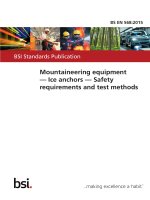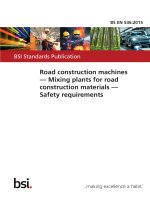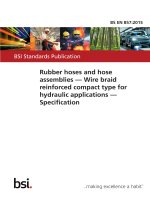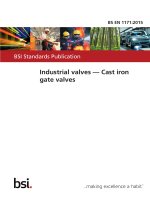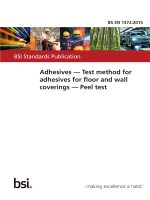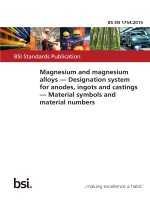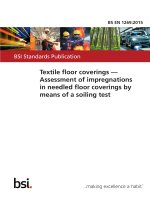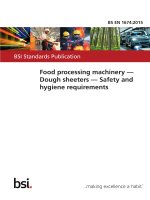Bsi bs en 00488 2015
Bạn đang xem bản rút gọn của tài liệu. Xem và tải ngay bản đầy đủ của tài liệu tại đây (1.67 MB, 34 trang )
BS EN 488:2015
BSI Standards Publication
District heating pipes —
Preinsulated bonded pipe
systems for directly buried
hot water networks — Steel
valve assembly for steel service
pipes, polyurethane thermal
insulation and outer casing of
polyethylene
BS EN 488:2015
BRITISH STANDARD
National foreword
This British Standard is the UK implementation of EN 488:2015.
It supersedes BS EN 488:2011 which is withdrawn.
The UK participation in its preparation was entrusted to Technical
Committee RHE/9, Insulated underground pipelines.
A list of organizations represented on this committee can be
obtained on request to its secretary.
This publication does not purport to include all the necessary
provisions of a contract. Users are responsible for its correct
application.
© The British Standards Institution 2015.
Published by BSI Standards Limited 2015
ISBN 978 0 580 85226 8
ICS 23.060.01
Compliance with a British Standard cannot confer immunity from
legal obligations.
This British Standard was published under the authority of the
Standards Policy and Strategy Committee on 30 November 2015.
Amendments/corrigenda issued since publication
Date
Text affected
BS EN 488:2015
EN 488
EUROPEAN STANDARD
NORME EUROPÉENNE
EUROPÄISCHE NORM
November 2015
ICS 23.060.01
Supersedes EN 488:2011+A1:2014
English Version
District heating pipes - Preinsulated bonded pipe systems
for directly buried hot water networks - Steel valve
assembly for steel service pipes, polyurethane thermal
insulation and outer casing of polyethylene
Tuyaux de chauffage urbain - Systèmes bloqués de
tuyaux préisolés pour les réseaux d'eau chaude
enterrés directement - Robinets préisolés pour tubes
de service en acier, isolation thermique en
polyuréthane et tube de protection en polyéthylène
Fernwärmerohre - Werkmäßig gedämmte
Verbundmantelrohrsysteme für direkt erdverlegte
Fernwärmenetze - Vorgedämmte Absperrarmaturen
für Stahlmediumrohre mit PolyurethanWärmedämmung und Außenmantel aus Polyethylen
This European Standard was approved by CEN on 5 September 2015.
CEN members are bound to comply with the CEN/CENELEC Internal Regulations which stipulate the conditions for giving this
European Standard the status of a national standard without any alteration. Up-to-date lists and bibliographical references
concerning such national standards may be obtained on application to the CEN-CENELEC Management Centre or to any CEN
member.
This European Standard exists in three official versions (English, French, German). A version in any other language made by
translation under the responsibility of a CEN member into its own language and notified to the CEN-CENELEC Management
Centre has the same status as the official versions.
CEN members are the national standards bodies of Austria, Belgium, Bulgaria, Croatia, Cyprus, Czech Republic, Denmark, Estonia,
Finland, Former Yugoslav Republic of Macedonia, France, Germany, Greece, Hungary, Iceland, Ireland, Italy, Latvia, Lithuania,
Luxembourg, Malta, Netherlands, Norway, Poland, Portugal, Romania, Slovakia, Slovenia, Spain, Sweden, Switzerland, Turkey and
United Kingdom.
EUROPEAN COMMITTEE FOR STANDARDIZATION
COMITÉ EUROPÉEN DE NORMALISATION
EUROPÄISCHES KOMITEE FÜR NORMUNG
CEN-CENELEC Management Centre: Avenue Marnix 17, B-1000 Brussels
© 2015 CEN
All rights of exploitation in any form and by any means reserved
worldwide for CEN national Members.
Ref. No. EN 488:2015 E
BS EN 488:2015
EN 488:2015 (E)
Contents
Page
European foreword....................................................................................................................................................... 4
Introduction .................................................................................................................................................................... 5
1
Scope .................................................................................................................................................................... 6
2
Normative references .................................................................................................................................... 6
3
Terms and definitions ................................................................................................................................... 7
4
4.1
4.1.1
4.1.2
4.2
4.3
4.3.1
4.3.2
4.3.3
4.3.4
4.3.5
4.4
4.4.1
4.4.2
4.4.3
4.5
4.5.1
4.5.2
4.6
4.6.1
4.6.2
4.6.3
4.6.4
4.7
4.8
Requirements ................................................................................................................................................... 8
Pressure ratings for valves .......................................................................................................................... 8
General ................................................................................................................................................................ 8
Valves without indicated flow direction ................................................................................................. 8
Service temperatures for valves ................................................................................................................ 9
Steel parts .......................................................................................................................................................... 9
General ................................................................................................................................................................ 9
Valve..................................................................................................................................................................... 9
Valve extension pipe ...................................................................................................................................... 9
Welding ends .................................................................................................................................................... 9
Welding of steel parts .................................................................................................................................... 9
Casing .................................................................................................................................................................. 9
General ................................................................................................................................................................ 9
Requirements for polyethylene welding ................................................................................................ 9
Diameter and wall thickness of the casing.......................................................................................... 10
Polyurethane rigid foam insulation (PUR) ......................................................................................... 10
General ............................................................................................................................................................. 10
Minimum insulation thickness................................................................................................................ 10
Valve assembly .............................................................................................................................................. 10
Ends of valve assembly............................................................................................................................... 10
End of stem construction ........................................................................................................................... 10
Main dimensions of the valve assembly............................................................................................... 11
Installation of measuring elements ....................................................................................................... 12
Requirements for effective operation and maintenance............................................................... 12
Resistance to axial forces and bending moments............................................................................. 12
5
5.1
5.2
5.2.1
5.2.2
5.2.3
5.3
5.3.1
5.3.2
5.3.3
5.4
5.4.1
5.4.2
5.5
5.6
5.7
Testing, test methods and test requirements .................................................................................... 13
General ............................................................................................................................................................. 13
Test specimens .............................................................................................................................................. 13
General ............................................................................................................................................................. 13
Test specimens for type testing steel parts of valve ........................................................................ 13
Test specimens from casings and polyurethane foam.................................................................... 13
Steel parts ....................................................................................................................................................... 13
General ............................................................................................................................................................. 13
Type test of the steel parts ........................................................................................................................ 13
Production testing of valves ..................................................................................................................... 17
Casing ............................................................................................................................................................... 18
General ............................................................................................................................................................. 18
Leak-tightness of the welded casing ..................................................................................................... 18
Polyurethane rigid foam insulation ...................................................................................................... 18
Valve assembly .............................................................................................................................................. 18
Surveillance system..................................................................................................................................... 18
2
BS EN 488:2015
EN 488:2015 (E)
6
6.1
6.2
6.3
6.4
Marking ............................................................................................................................................................ 18
General ............................................................................................................................................................. 18
Steel valve........................................................................................................................................................ 18
Casing ................................................................................................................................................................ 18
Valve assembly .............................................................................................................................................. 19
7
Installation and maintenance .................................................................................................................. 19
Annex A (informative) Guidelines for inspection and testing ..................................................................... 20
A.1
General ............................................................................................................................................................. 20
A.2
Manufacturer’s type test ............................................................................................................................ 20
A.3
Manufacturer’s quality control ................................................................................................................ 20
A.4
External inspection ...................................................................................................................................... 20
A.5
Extent of inspection ..................................................................................................................................... 20
A.6
Manufacturer’s responsibility ................................................................................................................. 20
Annex B (normative) Resistance to axial force and bending moment ..................................................... 22
B.1
Axial strength test ........................................................................................................................................ 22
B.2
Bending test .................................................................................................................................................... 22
Annex C (normative) Resistance to bending forces ........................................................................................ 24
C.1
General ............................................................................................................................................................. 24
C.2
Standard test assembly (four point bending test) ............................................................................ 25
Bibliography ................................................................................................................................................................. 29
3
BS EN 488:2015
EN 488:2015 (E)
European foreword
This document (EN 488:2015) has been prepared by Technical Committee CEN/TC 107 “Prefabricated
district heating and district cooling pipe systems”, the secretariat of which is held by DS.
This European Standard shall be given the status of a national standard, either by publication of an
identical text or by endorsement, at the latest by May 2016, and conflicting national standards shall be
withdrawn at the latest by May 2016.
Attention is drawn to the possibility that some of the elements of this document may be the subject of
patent rights. CEN [and/or CENELEC] shall not be held responsible for identifying any or all such patent
rights.
This document supersedes EN 488:2011+A1:2014.
In comparison with the previous edition, the main changes in EN 488:2015 are:
— improvement and simplification of the type test of the steel valve. The cycle test has been
integrated in the test sequence;
— the formulae in Annex C for the calculation of bending forces have been improved. C.1.3 of
EN 488:2011+A1:2014 concerning alternative test application for diameters DN ≤ 200 mm, has
been deleted.
According to the CEN/CENELEC Internal Regulations, the national standards organizations of the
following countries are bound to implement this European Standard: Austria, Belgium, Bulgaria,
Croatia, Cyprus, Czech Republic, Denmark, Estonia, Finland, Former Yugoslav Republic of Macedonia,
France, Germany, Greece, Hungary, Iceland, Ireland, Italy, Latvia, Lithuania, Luxembourg, Malta,
Netherlands, Norway, Poland, Portugal, Romania, Slovakia, Slovenia, Spain, Sweden, Switzerland,
Turkey and the United Kingdom.
4
BS EN 488:2015
EN 488:2015 (E)
Introduction
EN 488 has also been aligned with EN 448 and other relevant European Standards.
Other standards from CEN/TC 107 are:
— EN 253, District heating pipes — Preinsulated bonded pipe systems for directly buried hot water
networks — Pipe assembly of steel service pipe, polyurethane thermal insulation and outer casing of
polyethylene;
— EN 448, District heating pipes — Preinsulated bonded pipe systems for directly buried hot water
networks — Fitting assemblies of steel service pipes, polyurethane thermal insulation and outer casing
of polyethylene;
— EN 489, District heating pipes — Preinsulated bonded pipe systems for directly buried hot water
networks — Joint assembly for steel service pipes, polyurethane thermal insulation and outer casing of
polyethylene;
— EN 13941, Design and installation of preinsulated bonded pipe systems for district heating;
— EN 14419, District heating pipes — Preinsulated bonded pipe systems for directly buried hot water
networks — Surveillance systems;
— EN 15632 (all parts), District heating pipes — Pre-insulated flexible pipe systems;
— EN 15698-1, District heating pipes — Preinsulated bonded twin pipe systems for directly buried hot
water networks — Part 1: Twin pipe assembly of steel service pipe, polyurethane thermal insulation
and outer casing of polyethylene;
— EN 15698-2, District heating pipes — Preinsulated bonded twin pipe systems for directly buried hot
water networks — Part 2: Fitting and valve assembly of steel service pipes, polyurethane thermal
insulation and outer casing of polyethylene.
5
BS EN 488:2015
EN 488:2015 (E)
1 Scope
This European Standard specifies requirements and test methods for valves of prefabricated thermally
insulated valve assemblies comprising a steel valve, rigid polyurethane foam insulation and an outer
casing of polyethylene for use in directly buried hot water networks with pre-insulated pipe assemblies
in accordance with EN 253.
This European Standard applies only to factory made prefabricated insulated valve assemblies for
continuous operation with hot water at various temperatures in accordance with
EN 253:2009+A2:2015, Clause 1 and the valve assemblies with a maximum operation pressure of
25 bar. For higher pressures, additional demands apply.
NOTE
For this application, the following valve types are commonly used: ball valves, gate valves, and
butterfly valves.
This European Standard does not include calculation rules for loads and stresses. These depend on the
configuration of the system as it is installed. The design and installation rules are given in EN 13941.
2 Normative references
The following documents, in whole or in part, are normatively referenced in this document and are
indispensable for its application. For dated references, only the edition cited applies. For undated
references, the latest edition of the referenced document (including any amendments) applies.
EN 19, Industrial valves — Marking of metallic valves
EN 253:2009+A2:2015, District heating pipes — Preinsulated bonded pipe systems for directly buried hot
water networks — Pipe assembly of steel service pipe, polyurethane thermal insulation and outer casing of
polyethylene
EN 448:2015, District heating pipes — Preinsulated bonded pipe systems for directly buried hot water
networks — Fitting assemblies of steel service pipes, polyurethane thermal insulation and outer casing of
polyethylene
EN 736-1, Valves - Terminology — Part 1: Definition of types of valves
EN 10088-1:2014, Stainless steels — Part 1: List of stainless steels
EN 10204, Metallic products — Types of inspection documents
EN 12266-1, Industrial valves — Testing of metallic valves — Part 1: Pressure tests, test procedures and
acceptance criteria — Mandatory requirements
EN 12502-4, Protection of metallic materials against corrosion — Guidance on the assessment of
corrosion likelihood in water distribution and storage systems — Part 4: Influencing factors for stainless
steels
EN 13941:2009+A1:2010, Design and installation of preinsulated bonded pipe systems for district heating
EN 14419, District heating pipes — Preinsulated bonded pipe systems for directly buried hot water
networks — Surveillance systems
EN ISO 12944-2, Paints and varnishes — Corrosion protection of steel structures by protective paint
systems — Part 2: Classification of environments (ISO 12944-2)
6
BS EN 488:2015
EN 488:2015 (E)
EN ISO 12944-5, Paints and varnishes — Corrosion protection of steel structures by protective paint
systems — Part 5: Protective paint systems (ISO 12944-5)
3 Terms and definitions
For the purposes of this document, the terms and definitions given in EN 253:2009+A2:2015 and
EN 448 and the following apply. For types of valves, the terms and definitions given in EN 736-1 apply.
3.1
nominal pressure (PN) class
alphanumeric designation used for reference purposes related to a combination of mechanical and
dimensional characteristics of a component of a pipe work system
Note 1 to entry:
It comprises the letters PN followed by a dimensionless number.
Note 3 to entry:
number.
The designation PN is not meaningful unless it is related to the relevant component standard
Note 2 to entry: The number following the letters PN does not represent a measurable value and should not be
used for calculation purposes except where specified in the relevant standard.
Note 4 to entry: The maximum allowable pressure of a pipework component depends on the PN number, the
material and design of the component, its maximum allowable temperature, etc. The relevant European
Component standards include tables of specified pressure/temperature ratings or, in minimum, include rules how
to determine pressure/temperature ratings.
Note 5 to entry: It is intended that all components with the same PN and DN designations have the same mating
dimensions for compatible flange types.
[SOURCE: EN 1333:2006, 2.1, modified – added Note 1 to entry.]
3.2
maximum operation pressure
maximum internal pressure acting against the pipe wall at any point or in any section of the pipeline at
a given operating temperature
[SOURCE: EN 13941:2009+A1:2010, 3.1.19, modified]
3.3
nominal size
DN
alphanumeric designation of size, common to components in piping systems which are used for
reference purposes
[SOURCE: EN ISO 6708:1995, 2.1, modified]
3.4
valve assembly
assembly of valve, valve extension pipe, PE-casing and PUR-foam
Note 1 to entry:
Figure 1 gives an example of a valve assembly and its components.
7
BS EN 488:2015
EN 488:2015 (E)
Key
a
valve
c
valve assembly
b
d
e
valve extension pipe
service pipe
insulation
Figure 1 — Example valve assembly components
3.5
valve
part of the valve assembly supplied by the valve manufacturer (with or without valve extension pipe)
3.6
valve extension pipe
pipe part of the valve assembly welded to the valve
Note 1 to entry: The valve extension may be required before the insulation process. This can be done by the
valve manufacturer or the insulation manufacturer. The valve can be extended with valve extension pipes before
insulation or delivered by the valve manufacturer with extensions.
3.7
steel service pipe
service pipe according to EN 253:2009+A2:2015
4 Requirements
4.1 Pressure ratings for valves
4.1.1 General
The valves shall be designed for use in pipe systems with a maximum operating pressure of 16 bar or
25 bar.
The valves shall be able to withstand a strength test pressure of the district heating system of 1,3
times the maximum operating pressure at ambient temperature in open and closed position.
4.1.2 Valves without indicated flow direction
Valves without an indicated flow direction shall support the pressure load in both directions.
8
BS EN 488:2015
EN 488:2015 (E)
4.2 Service temperatures for valves
The valves shall be able to withstand continuous operation with hot water at various temperatures in
accordance with EN 253:2009+A2:2015 and at a minimum water temperature of 4 °C.
4.3 Steel parts
4.3.1 General
All valves, steel pipes and steel components used for manufacturing of valve assemblies under the scope
of this European Standard shall as a minimum be delivered to the manufacturer with an inspection
certificate 3.1 according to EN 10204. The manufacturer shall keep documentation of the inspection
certificates.
In case a material related inspection certificate 3.1 according to EN 10204 is required by the client who
orders the preinsulated valve assemblies, this information shall be given while placing the order with
the manufacturer of the preinsulated valve assemblies.
NOTE
Any later request for provision of such documentation can be too late and can possibly not be met by
the manufacturer, since the manufacturer has to organize the assignment of 3.1 certificates to valves and valve
assemblies before starting the production.
4.3.2 Valve
The valve shall be fully welded. Detachable joints, such as flanged or screwed connections, except
sealing system at the stem, shall not be used in the pressurized area.
4.3.3 Valve extension pipe
The quality of the valve body shall match with the quality of the valve extension pipe.
4.3.4 Welding ends
The welding ends of the valve assembly shall match with the service pipe in accordance with
EN 253:2009+A2:2015, 4.2.2.
Pipe ends shall be prepared in accordance with EN 448:2015, 4.1.10.3.
4.3.5 Welding of steel parts
Fusion welding between valves and valve extension pipe, shall be carried out in accordance with
EN 448:2015, 4.1.10.
The quality of the steel at the welding ends of the valve or valve assembly shall match with steel of the
service pipes.
Welding of pressurized parts of the valve assembly shall comply with EN 448:2015, 4.1.10.2 and
4.1.10.5.
4.4 Casing
4.4.1 General
The casing shall be in accordance with EN 448:2015 and EN 253:2009+A2:2015.
4.4.2 Requirements for polyethylene welding
The general requirements for polyethylene welding shall be in accordance with EN 448:2015, 4.4.3.
9
BS EN 488:2015
EN 488:2015 (E)
4.4.3 Diameter and wall thickness of the casing
The outside diameter and the minimum wall thickness of the PE casing shall be in accordance with
EN 448:2015, 4.4.5.
4.5 Polyurethane rigid foam insulation (PUR)
4.5.1 General
The requirements for PUR shall be the same as in EN 448:2015, 4.3 when tested in accordance with 5.5
of this European Standard.
4.5.2 Minimum insulation thickness
The minimum insulation thickness shall be in accordance with EN 448:2015, 4.4.6.
4.6 Valve assembly
4.6.1 Ends of valve assembly
4.6.1.1 General
The ends of the valve extension pipe of the valve assembly shall be prepared for welding according to
4.3.3 and shall be free from insulation for a minimum length of 150 mm. The tolerance in the declared
value shall be ± 10 mm.
4.6.1.2 Centre line deviation
The distance between the centre lines of the valve extension pipe and the casing at the ends of the valve
assembly shall not exceed the limits given in EN 253:2009+A2:2015, Table 7.
The centre line deviation shall be measured between the centre lines with the largest deviation.
4.6.1.3 Angular deviation
The angular deviation between the centre lines of the not insulated ends of the valve extension pipe at
the length of 100 mm from the ends shall not exceed 2°.
The angular deviation shall be measured between the centre lines with the largest deviation.
4.6.2 End of stem construction
To ensure a long service life of the end stem passing through the casing, it shall withstand the
aggressive underground condition such as heat, cold, moisture, ground and salty water. Where the stem
construction passes the casing there shall be an arrangement to protect against water ingress to the
insulation.
The stem construction outside the insulation shall be:
— made from stainless steel as defined in EN 10088-1:2014, 3.1, however minimum specified Crcontent is 16 %. Factors influencing the corrosion probability of the stainless steel construction can
be assessed according to EN 12502-4.
Specifically used steel type is documented by appropriate quality management system;
NOTE
Under specific installation and operation conditions a chrome content of 16 % alone might not be
sufficient, so that other alloy elements are then recommended.
— or made from carbon steel and protected by a paint system securing durability range “high”
according to EN ISO 12944-5. Underground installed valves shall be suitable for corrosivity
10
BS EN 488:2015
EN 488:2015 (E)
categories of Im1, Im2 and Im3 according to EN ISO 12944-2 and for atmospheric-corrosivity
categories C5-M and C5-I according to EN ISO 12944-2.
Specifically used paint system shall be according to EN ISO 12944-5 and documented by
appropriate quality management system.
The protection by corrosion resistant material or corrosion protecting paint shall be added at the length
of at least 100 mm from the top of the ‘stem house’ (see Figure 2).
Figure 2 — Anti corrosion protection of the stem construction
4.6.3 Main dimensions of the valve assembly
The main dimensions of the valve assembly H and L are shown in Figure 3.
The values of the main dimensions “L” and “H” are to be declared by the manufacturer.
The tolerances of the valve assembly dimensions shown in Figure 3 shall be in accordance with Table 1.
Table 1 — Tolerances on the main valve dimensions
DN
≤ 300
> 300
H
mm
L
mm
±10
±50
±5
±20
11
BS EN 488:2015
EN 488:2015 (E)
Figure 3 — Main dimensions
4.6.4 Installation of measuring elements
Measuring elements for surveillance systems shall be in accordance with EN 14419.
4.7 Requirements for effective operation and maintenance
The design of the valve shall make it possible to operate the valve outside the insulation.
The valve shall close when turned clockwise and open when turned anti-clockwise.
The stem construction shall make it possible to manoeuvre the valve by means of a T key from ground
level.
NOTE 1
Commonly used keyways are 19 mm, 27 mm, 36 mm, 50 mm and 60 mm or conical quadrangle
27 mm/ 32 mm.
Butterfly valves with nominal diameter DN 100 and larger, ball valves and gate valves with nominal
diameter DN 200 and larger shall be provided with a gear or a connection for an actuator to ensure
controlled manoeuvring of the valve.
NOTE 2
Commonly used keyways for connections for actuators are 60 mm, 70 mm and 90 mm, or conical
quadrangle 27 mm/32 mm.
Valves shall be provided with a stop device that can be replaced without removing the insulation.
Alternatively, an internal stop device can be used. The internal stop device shall be designed to resist a
maximum strength torque of at least twice the maximum operating torque specified by the
manufacturer with a minimum of 150 Nm in the fully open and fully closed position of the valve. Using
an internal stop device, the valve stem shall be designed to resist a maximum strength torque of at least
1,5 times the designed strength torque of the stop device.
The sealing around the stem shall be capable of being maintained without removing the insulation.
4.8 Resistance to axial forces and bending moments
The resistance of the valves to axial forces and bending moments shall comply with Table B.1.
12
BS EN 488:2015
EN 488:2015 (E)
5 Testing, test methods and test requirements
5.1 General
This clause specifies test methods, test sequence, test conditions and required test results for type and
production testing.
Where test requirements specified in this European Standard differ from those in other standards
referred to, the requirements described in this European Standard shall apply.
NOTE
Informative Annex A of this European Standard gives guidelines for inspection and testing.
5.2 Test specimens
5.2.1 General
Test specimens shall be representative for the production.
5.2.2 Test specimens for type testing steel parts of valve
The tests for axial forces, bending moments and torque are type tests for a range of valves with the
same construction principle, design and materials.
To qualify a whole product range with the same construction principle, design and materials, two valve
sizes within this product range shall be tested. The qualification shall be valid from half the size of the
smaller valve (but limited by smallest valve size of the product range under consideration) and twice
the size of the bigger valve (but limited by the largest valve size of the product range under
consideration) which were tested.
If the construction principle, design and materials are not the same for the whole product range, the
product range shall be split in separate ranges (where the construction principle, design and materials
are the same) and the above mentioned rule shall be applied to each split range. The manufacturer is
responsible to ensure that the complete test sequence as specified in this European Standard is carried
out and all test results are documented.
5.2.3 Test specimens from casings and polyurethane foam
The test specimens from casing and polyurethane foam shall be taken in accordance with EN 448:2015,
5.2.
5.3 Steel parts
5.3.1 General
This clause describes the type test and production test of the steel parts.
5.3.2 Type test of the steel parts
5.3.2.1 General
The type test shall be done on the same valve.
The type test shall be carried out on the same valve for the whole test sequence and executed in the
order given in Table 2. The mandatory clauses shall be carried out as a minimum in the test program.
13
BS EN 488:2015
EN 488:2015 (E)
Table 2 — Overview and sequence of the type test program
Test sequence
Mandatory
clauses
Optional
clauses
5.3.2.2
5.3.2.4
5.3.2.5
5.3.2.6
5.3.2.7
5.3.2.2
5.3.2.3
5.3.2.4
Name of the test
5.3.2.3
5.3.2.3
5.3.2.4
5.3.2.3
5.3.2.4
5.3.2.3
5.3.2.4
Leak-tightness of shell and stem casing of the unloaded valve
Leak-tightness of the seat of the unloaded valve
Torque load measurement of the unloaded valve
Leak-tightness of the seat of the unloaded valve
Torque load measurement of the unloaded valve
Axial compressive force test
Leak-tightness of the seat of the unloaded valve
Torque load measurement of the unloaded valve
Axial tensile force test
Leak-tightness of the seat of the unloaded valve
Torque load measurement of the unloaded valve
Bending test
Leak-tightness of shell and stem casing of the unloaded valve
Leak-tightness of the seat of the unloaded valve
Torque load measurement of the unloaded valve
5.3.2.2 Leak-tightness of shell and stem casing of the unloaded valve
Test condition:
— according to EN 12266-1, P10 and P11, type test.
Test requirement:
— shell and stem casing shall be leak-tight.
5.3.2.3 Leak-tightness of the seat of the unloaded valve
Test condition:
— according to EN 12266-1, P12, type test.
Test requirement:
— the maximum seat leakage of the seat during the test shall be in accordance to EN 12266-1,
test number P12 rate A for valves up to DN 400 or rate B for valves higher than DN 400;
— for the last mandatory leak tightness test after completion of the whole test sequence (axial
compressive force, axial tensile force and bending test) the maximum seat leakage rate B is
acceptable for all valve sizes.
5.3.2.4 Torque load measurement of unloaded valve
Test conditions:
— valve filled with water at temperature (25 ± 10) °C.
14
BS EN 488:2015
EN 488:2015 (E)
Test requirements:
— the torque value in any test shall not be higher than 100 % of the maximum value in the technical
specification of the manufacturer;
— the torque shall be measured and recorded when opening and closing the valve;
— all test torque measurements shall be recorded and stated in test reports for evaluation.
5.3.2.5 Axial compressive force test
Test conditions:
— valve shall be in an open position;
— valve loaded with an axial compressive force in accordance with Table B.1;
— internal water pressure for the valve accordance with the nominal pressure class PN of the valve;
— valve filled with water at temperature (90 ± 5) °C. Forming of steam shall be prevented at all times;
— test duration shall be 48 h;
— compressive force, water pressure, water temperature shall be measured and recorded
continuously;
— torque, when opening and closing of the valve, shall be measured and recorded at least 24 times
during the test period of 48 h with a minimum of 30 min between the measurements;
— before the valve is opened to measure the torque, the pressure at one side of the valve shall be
relieved to zero pressure;
— the last measurement of the torque will be done at the end of the 48-h test period.
Test requirements:
— the valve shall be able to withstand the axial compressive force, according to Table B.1, without
leaking or damaging;
— the maximum torque value shall not be higher than 100 % of the maximum value in the technical
specification of the manufacturer.
5.3.2.6 Axial tensile force test
Test conditions:
— valve shall be in an open position;
— valve loaded with an axial tensile force in accordance with Table B.1;
— internal water pressure in accordance with the nominal pressure class PN of the valve;
— valve filled with water at temperature (25 ± 10) °C;
— test duration shall be 48 h;
— tensile force, water pressure, water temperature shall be measured and recorded continuously;
15
BS EN 488:2015
EN 488:2015 (E)
— torque, when opening and closing of the valve, shall be measured and recorded at least 16 times
(open and close) during the test period of 48 h with a minimum of 30 min between the
measurements;
— after the valve is closed while measuring the torque, the pressure at one side of the valve shall be
relieved to zero pressure, before opening the valve while measuring the torque (again);
— the last measurement of the torque will be done at the end of the 48-h test period.
Test requirements:
— the valve shall be able to withstand the axial tensile force, according to Table B.1, without leaking or
damaging;
— the maximum torque value shall not be higher than 100 % of the maximum value in the technical
specification of the manufacturer.
5.3.2.7 Bending test
The bending test shall be performed in accordance with Annex B and Annex C.
Test conditions:
— valve shall be in an open position;
— valve loaded with a bending moment in accordance with Table B.1;
— internal water pressure in accordance with the nominal pressure class PN of the valve;
— the bending test shall be carried out at temperature of (25 ± 10) °C;
— test medium is water;
— test duration shall be 8 h (two times);
— the test can be executed for all diameters according to the four points bending test, described in
Annex C;
— when opening and closing of the valve, shall be measured and recorded at least 8 times (open and
close) during the test period of 8 h with a minimum of 30 min between the measurements.
— after the valve is closed while measuring the torque, the pressure at one side of the valve shall be
relieved to zero pressure, before opening the valve while measuring the torque (again);
— the last measurement of the torque will be done at the end of the 8-h test period;
— the test shall be executed two times (in two planes), one plane defined by the axis of the stem and
the pipe axis, the second plane defined by an axis perpendicular to the axis of the stem and the pipe
axis.
Test requirements:
— the valve body shall be able to withstand the bending moment, according to Table B.1, without
leaking or damaging;
16
BS EN 488:2015
EN 488:2015 (E)
— after loading, the applied torque in open and closed direction shall be measured. The maximum
torque value shall not be higher than 100 % of the maximum value in the technical specification of
the manufacturer.
5.3.3 Production testing of valves
5.3.3.1 General
Production tests on valves shall be carried out as in Table 3.
Table 3 — Overview of the production tests
Order
Test
Clause
1
Leak-tightness of shell and stem casing of the unloaded valve
5.3.3.2
3
Testing of steel welds
5.3.3.4
2
4
Leak-tightness of the seat of the unloaded valve
Torque load measurement of unloaded valve
5.3.3.2 The leak-tightness test of the shell and stem casing
5.3.3.3
5.3.3.5
Test condition:
— the leak-tightness test of the shell and stem casing shall be carried out in accordance with
EN 12266-1, shell tightness (test reference, P11), production test.
Test requirement:
— the shell and stem casing shall be leak-tight.
5.3.3.3 The leak-tightness test of the seat
Test condition:
— the leak-tightness test of the seat shall be carried out in accordance with EN 12266-1, seat tightness
(test reference, P12), production test.
Test requirement:
— the maximum seat leakage of the seat during the test shall be conform to EN 12266-1, test number
P12 rate A for valves up to DN 400 or rate B for valves higher than DN 400.
5.3.3.4 Testing of steel welds
Steel welds in accordance with 4.3.5 shall be tested in accordance with EN 448:2015, 5.3.
5.3.3.5 Torque load measurement of unloaded valve
Test condition:
— valve filled with water at temperature (25 ± 10) °C;
Test requirements:
— the torque value in any test shall not be higher than 100 % of the maximum value in the technical
specification of the manufacturer;
— the torque shall be measured and recorded when opening and closing the valve;
17
BS EN 488:2015
EN 488:2015 (E)
— all test torque measurements shall be recorded and stated in test reports for evaluation.
5.4 Casing
5.4.1 General
Casings in accordance with 4.4 shall be tested in accordance with EN 253:2009+A2:2015, 5.2.
5.4.2 Leak-tightness of the welded casing
The leak-tightness of the welding in the casing after foaming shall be examined in accordance with
EN 448:2015, 4.4.4.
5.5 Polyurethane rigid foam insulation
The polyurethane foam insulation shall be tested in accordance with EN 448:2015, 5.5. Test specimens
shall be taken and cut in accordance with EN 448:2015, 5.2.
5.6 Valve assembly
Valve assemblies in accordance with 4.6 shall be tested in accordance with EN 448:2015, 5.6.
5.7 Surveillance system
When measuring elements for a surveillance system are installed in the valve assembly, test for
controlling the function of the installed measuring elements shall be performed. The test shall be
performed according to EN 14419, section for manufacturing of pipe elements with measuring
elements.
6 Marking
6.1 General
The valve assembly shall be marked by any suitable method which does not affect the functional
properties of the casing, and which is able to withstand conditions of handling, storage and use.
All marking shall be legible on the valve assembly.
6.2 Steel valve
The steel valve shall be marked according to EN 19:
a) valves shall be marked with the allowable service pressure and temperature;
b) ball valves, butterfly valves and gate valves shall be marked permanently with closed and open
positions.
6.3 Casing
The manufacturer of the casing shall mark thereon:
a) raw material of the PE, by trade name or code;
b) MFR – table value as declared by the raw material supplier;
c) nominal diameter and nominal wall thickness of the casing;
d) year and week of manufacture;
18
BS EN 488:2015
EN 488:2015 (E)
e) manufacturer’s identification.
6.4 Valve assembly
The manufacturer of the valve assemblies shall mark on the casing:
a) pressure rating of the valve in accordance with 4.1.1;
b) nominal diameter and nominal wall thickness of the valve ends;
c) steel specification and grade of the valve end;
d) manufacturer's identification;
e) steel valve manufacturer’s identification (possibly by a code);
f)
number of this European Standard;
g) year and week of foaming;
h) type of physical blowing agent, if any;
i)
j)
information about the diffusion barrier, if any;
production year and month of the valve.
7 Installation and maintenance
The valve manufacturer shall provide clear and unambiguous installation and maintenance
instructions.
Maintenance shall be possible without damaging the insulation and without influencing the operation of
the pipeline.
19
BS EN 488:2015
EN 488:2015 (E)
Annex A
(informative)
Guidelines for inspection and testing
A.1 General
The following inspection frequencies are recommended to ensure that manufactured pre-insulated
valves comply with the requirements specified in this European Standard.
A quality system certified to be in accordance with EN ISO 9001 with reference to EN 488 and the
obtained statistics of consistency of test results can be used to adjust inspection frequencies to the
actual needs.
The recommended inspection includes the following:
A.2 Manufacturer’s type test
A type test is used to obtain an initial validation of materials and production methods. A new test should
be performed where these materials or methods are essentially changed.
A.3 Manufacturer’s quality control
The manufacturer’s quality control is applied to ensure that the intended quality level of the products is
maintained. The manufacturer is responsible for ensuring that the tests specified in this European
Standard are carried out and the results recorded.
A.4 External inspection
This inspection is primarily intended as an evaluation of the extent and the proper functioning of the
manufacturer’s quality control. This inspection also includes sampling of products to ensure that the
requirements specified in this European Standard are fulfilled.
A.5 Extent of inspection
The suggested extent of the inspection carried out by the steel valve manufacturer is given in Table A.1.
The suggested extent of the inspection carried out by the manufacturer of the valve assembly is given in
Table A.2.
External inspection should normally be made at least once a year.
A.6 Manufacturer’s responsibility
Where a manufacturer makes their own raw material or produces parts for which there is a
requirement for “manufacturer’s certificates”, the manufacturer of the valve assembly should take over
the responsibilities of the supplier.
20
BS EN 488:2015
EN 488:2015 (E)
Table A.1 — Steel valve inspection
Clause
Item
Test frequency
Steel valve
type test
manufacturer’s Steel valve manufacturer’s External
inspection
quality control
5.3.2
Type test of the steel parts
5.3.2.1
Type test sequence and Mandatory tests of Table 2 on Check design and material Verify design and material
program
the same valve. Two valves in a qualifications against type test
qualifications against type test
range see 5.2.2
5.3.3
Production testing of valves
4.3.4
Welding ends of valves
- Inspection of delivery
5.3.3.2
Leak-tightness of shell
and stem casing of the
unloaded valve
100 %
Inspection of procedures and
internal reports
Leak-tightness of the
seat of the unloaded
valve
100 %
Inspection of procedures and
internal reports
Torque
measurement
unloaded valve
Statistic quality control
5.3.3.3
5.3.3.4
5.3.3.5
Clause
- Inspection of procedures and
- Statistic quality control of the internal reports
dimensions of the welding ends - check of dimensions on one
when produced by a the steel valve per size
valve manufacturer
Testing of steel welds
In
accordance
with Inspection of procedures and
EN 448:2015, Table A.1 when internal reports
welded
by
steel
valve
manufacturer
load
of
Item
Table A.2 — Valve assembly inspection
Test frequency
Valve
assembly Valve
manufacturer’s type test
manufacturer’s
control
4.3
4.4
4.5
4.6
Inspection of procedures and
internal reports
assembly External inspection
quality
Steel parts
See EN 448:2015, Table A.1
See EN 448:2015, Table A.1
See EN 448:2015, Table A.1
Polyurethane
See EN 448:2015, Table A.2
See EN 448:2015, Table A.2
See EN 448:2015, Table A.2
Polyethylene casing
Valve assembly
See EN 448:2015, Table A.2
See EN 448:2015, Table A.2
See EN 448:2015, Table A.2
See EN 448:2015, Table A.2
See EN 448:2015, Table A.2
See EN 448:2015, Table A.2
21
BS EN 488:2015
EN 488:2015 (E)
Annex B
(normative)
Resistance to axial force and bending moment
B.1 Axial strength test
In the axial strength test, executed according to 5.3.2.5 and 5.3.2.6 of this European Standard, the valves
shall be able to withstand conditions with a maximum axial tensile stress of 163 N/mm2 and an axial
compressive stress of 300 N/mm2 at ambient temperature respectively 265 N/mm2 (at 140 °C) due to
the temperature changes. The corresponding axial tensile and compressive forces are shown in
Table B.1.
NOTE
The maximum possible tensile stress is the estimated actual yield stress for steel grades, referred to in
EN 253:2009+A2:2015.
B.2 Bending test
In the bending test, executed according to 5.3.2.7 of this European Standard, the valves shall be able to
withstand conditions with a maximum bending moment. The test force is calculated assuming (in the
connecting service pipe) either a full plastic bending moment (up to DN 250) or an elastic bending
moment caused by thermal expansion and/or by a subsidence difference, from trenching activities, of
100 mm over 15 m. The corresponding bending moments and service pipe geometry are shown in
Table B.1.
NOTE
For a circular cross section, the full plastic bending moment equals 1,3 times the maximum elastic
bending moment. The maximum elastic bending moment is calculated with a maximum elastic bending stress,
equal to the estimated average actual yield stress (300 N/mm2 at ambient temperature) for steel grades, referred
to in EN 253:2009+A2:2015.
22
BS EN 488:2015
EN 488:2015 (E)
Table B.1 — Service pipe dimensions, axial test forces and test bending moments
Nominal
Outside diameter
Wall thickness of
Tensile force
Compressive
Test bending
diameter
of service pipe
(NOTE 2)
DN
Do
the service pipe
(NOTE 4)
force
(NOTES 1
and 3)
moment
(NOTES 5, 6 and 7)
mm
mm
kN
kN
Nm
26,9
2,0
26
41
15
21,3
25
33,7
20
32
40
50
65
80
42,4
48,3
60,3
76,1
88,9
100
114,3
150
168,3
125
200
250
300
350
400
450
500
600
700
800
900
1 000
1 200
139,7
219,1
273,0
323,9
355,6
406,4
457,0
508,0
610,0
711,0
813,0
t
2,0
2,3
2,6
2,6
2,9
37
53
4,5
5,0
650
139
2 800
140
228
204
4,0
60
350
85
61
3,6
3,6
209
1 200
109
3,2
32
86
2,9
99
177
251
4 600
6 950
332
13 100
547
32 300
408
337
495
1 600
19 900
804
62 200
686
1 116
108 100
5,6
1 004
1 632
132 200
6,3
1 454
5,6
6,3
6,3
7,1
8,0
8,8
914,0
10,0
1 220,0
12,5
1 016,0
20
11,0
913
1 291
1 619
2 192
2 880
3 624
4 629
5 661
7 729
1 484
120 200
2 098
144 300
2 364
156 400
2 423
168 500
3 087
192 600
3 926
314 600
4 761
476 400
6 144
7 439
9 636
702 400
878 800
1 385 900
NOTE 1
Compressive stress (actual hot value) up to: 265,0 [N/mm2].
NOTE 4
Above forces and stresses relate to pipes with dimensions and steel grades according to EN 253:2009+A2:2015, 4.2.
NOTE 2
NOTE 3
NOTE 5
NOTE 6
NOTE 7
Tensile stress (Cold value = 0,67 Re, 20) up to: 163,0 [N/mm2].
Compressive stress: according to EN 13941:2009+A1:2010, 6.4.2 (Limit state C1.4; Local buckling).
(DN 15 to DN 250) Calculated as full plastic bending moment for circular cross section.
(DN 600 to DN 1200) Calculated from subsidence difference (trenching activities).
(DN 300 to DN 500) Transition zone between NOTE 5 and NOTE 6.
23
